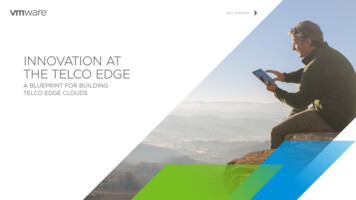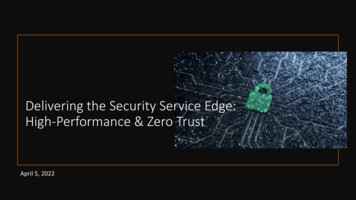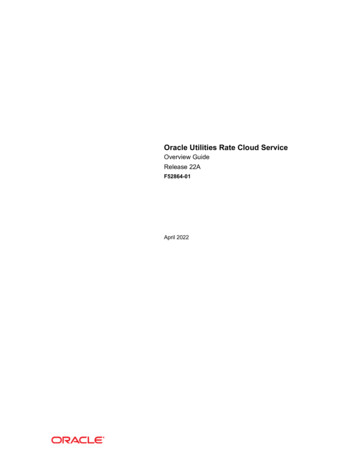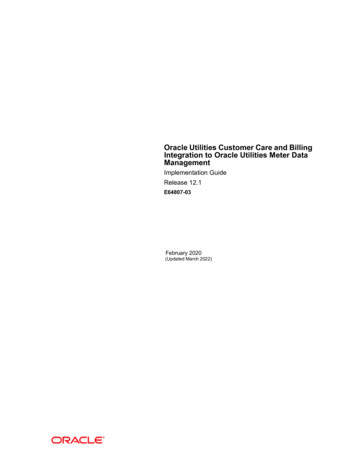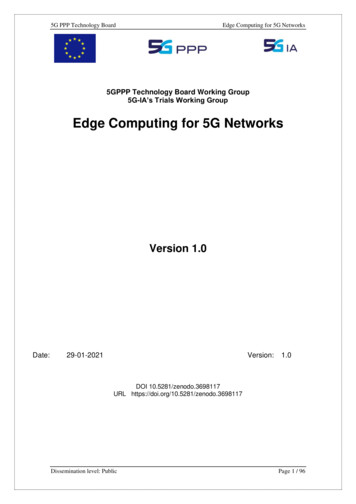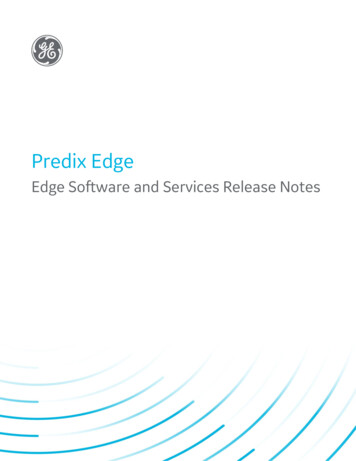
Transcription
1WHITE PAPERUTILITIES AT THE EDGE:Intelligent Management throughStrategic ModernizationAs electric utility leaders look for new ways tooptimize operations and management in the evolvingenergy market, many are using Edge and Internetof Things (IoT) technologies to turn enormousvolumes of data into actionable intelligence.Utility companies have implemented millions of smartmeters, generating significant amounts of data that mustbe harvested to offer insight into energy consumptionand demand. Deregulation continues to open the doorfor new, non-traditional competitors, especially in theEuropean market. At the same time, consumers arebecoming prosumers with expanding energy optionsand the ability to produce electricity from distributedenergy resources and microgrid technology. As a result,managing energy on the grid has become increasinglycomplex, necessitating more efficient solutions tomanage peak demand and maintain reliability.
W H I T E PA P E R To move forward their digital transformation, utilitycompanies are deploying Edge and IoT devices to manageand monitor electricity at a higher level of granularity thanthan in the past. Importantly, they also need a moderndistributed architecture and analytics capabilities totake full advantage of the data collected to deliver realtime insights that meet changing business demands.Utilities are using data collected from Edge and IoTinfrastructure to enhance operational efficiency and, asa result, service reliability. As an example, utility leadersare monitoring data from remote equipment to enableproactive maintenance, avoiding shutdowns. A data-drivenapproach can potentially reduce annual utility downtime by70% and can also potentially bring unplanned costs downto 22% of total expenditures, compared to 50% currently.1The Edge and IoT ecosystem, combined with a distributedanalytics architecture, creates valuable insights thatimprove efficiency, reliability, safety, affordability, andcustomer satisfaction – and provides an opportunity tocreate new, unregulated services that deliver additionalrevenue streams and diversify utility business models.THE GRID OF THE FUTUREHistorically, grid operators used past demand data toforecast needs and balance supply and demand.Today, grid technology has evolved to allow for two-waycommunication between the utility and its customers.Electricity flows outward from central power plants and,increasingly, into the grid from distributed sources includingconsumers generating power via solar and wind farms.To manage the grid in this increasingly complexenvironment, utility leaders are using digitaltransformation technologies and providing Edgecompute functionality to manage data velocity and/or perform advanced analytics at the source orpoint of collection. These leaders are working to: Enable (real-time) demand forecasting to reducecosts and drive affordable service: A complexset of equations determines how to managedemand and supply of energy on the grid.1Deloitte report from: Dell Technologies Energy Vertical Experienceand Vision PresentationCOMPUTER VISIONFOR UTILITIESComputer vision uses cameras (fixed or on dronesor other devices) as sensors to capture video dataalong with built-in analytics/machine learningcapabilities – right in the cameras – to theninspect assets, automate data analysis, and identifypatterns, anomalies, and perceived threats. Withthese capabilities, the Edge devices provide reliableinformation for condition-based maintenance,power grid management, energy deployment, andsecurity in the field. Utilities use the technology toimprove operations and asset restoration and takea proactive stance – reducing outages, and in turn,lowering maintenance costs and increasingcustomer satisfaction.As an example, computer vision cameras withmachine learning capabilities can remotely inspectassets through virtual site tours and run algorithmsto analyze and score the condition of those assets,prioritizing areas that need immediate attention.From a safety perspective, these cameras monitorfacilities or substations to identify personnel thatpose a threat or safety hazard. In areas wherevegetation management is an issue, drone analyticsplatforms can monitor vegetation overgrowth andencroachment around power lines, minimizing thepossibility of outages or wildfires.Utility companies can leverage the DellTechnologies IoT Solution for Safety and Security,powered by Intel, a software-defined infrastructuresystem with tightly integrated compute, storage,networking, and virtualization resources to helpimprove system performance and lower total costof ownership. It is purpose-built to a complexcamera-on-cloud infrastructure with support fordemanding mixed data sources including video,audio, weather conditions, and more.2
W H I T E PA P E R 3Figure 1: Enterprise-grade, end-to-end AI-ready computer vision platformSecurityTransformationOpen Data PortalCommand CenterPartner SolutionsAcross Devicesand DataStructuredData SourcesDataIngestionDBsData ServicesAPIData APIsAnalytics ent &IntegrationsQuery EngineFlat FilesSensorsData StoreData IngestionPipelinesMapsUnstructuredDatabasesData CatalogRules EngineSocial MediaImagesNormalized DataModelsInfrastructureVideosScale Out StorageSnapshot & ReplicationUtility companies need smart electronics to manageand monitor electricity in much more detail thanever before. In addition to smart devices, distributedanalytics at the Edge provides utilities with the abilityto monitor electricity generation and consumption,and manage peak demand. Bandwidth limitationscause network latency and limit analysis of harvesteddata, but Edge intelligence enables companies toextract valuable insights where data is collected, andtransfer only the most relevant data for quick insightto action. As a result, utilities can build a smart gridcapability that monitors all energy transactions anddeploys available energy resources intelligently Predict problems, deploy resources efficiently,and avoid outages to improve reliability: Witha distributed analytics architecture, utility leaderscan monitor systems, assets, facilities, and thegrid remotely. Suppliers can reduce routine andrepetitive tasks such as meter readings andinspections, saving time and resources. Cameras,drones and sensors monitor utility facilities,providing the ability to proactively prevent andquickly respond to maintenance issues. The devicesCloud Storagerun algorithms and analyze data at the Edge,monitoring the condition of assets to prioritizeissues and reduce outage risk, in real-time Modernize physical security to keep facilities andemployees safe: Use computer vision (cameras withbuilt-in analytics and machine learning capabilities) toinspect and monitor facilities, identify patterns, anddetect anomalies. This allows for the communicationof instantaneous safety hazard alerts. See Figure 1 fora detailed overview of a computer vision platform Automate operations, enabling new servicedevelopment and driving customer satisfaction:Utility companies can draw insights from the Edge andIoT infrastructure to create new products and servicesthat give customers flexibility, control, and affordableservices. For example, utility companies are moving totime-of-use (TOU) pricing, a model where the cost ofelectricity varies depending on when customers use it
W H I T E PA P E R C O N N E CT I N G C LO U D,S E C U R I T Y, A N D A N A LY T I C STO T H E U T I L I T I E S E D G EWhile utilities need a flexible infrastructure at the Edge,the solutions must run on a common framework toachieve a homogenous IoT architecture that can integratewith multi-cloud platforms as workloads dictate. EdgeCompute and Gateways can capture high-velocity dataand are critical components enabling distributed analyticsin both online and offline environments. This integrationis important as computational workloads can now runin a variety of different configurations – whether in apublic cloud, private cloud, on-premises, or at the Edge.Traditionally, organizations have built a data lake, labeledand combined their data, and applied machine learningon consolidated data sets. They generate models thatcan then help the technology perform specific tasks. Thechallenge is that the models require moving all data to onelocation to analyze. Today, given the increased volumeand velocity of data collected by smart meters, bandwidthrestraints, and regulatory issues, this is no longer a feasibleapproach on its own. Electric companies need a distributedanalytical AI capability where data is not relocated backto a central location each time it needs to be processed.Instead, utilities must incorporate machine learning at theEdge (so all data is not required to be transmitted) withdeep learning and AI at the core. This distributed analyticsmodel delivers a powerful continuous learning capability.From a security perspective, Edge and IoT ecosystemsrequire additional considerations, due to the increasednumber of hardware and software-based networkaccess points. This increases the criticality of cyberand physical security considerations when designingand managing these networks. Utilities need to addresssecurity concerns early in the development process,alongside data collection and application development.This said, the distributed analytics architecture andresulting insights can provide new (and previouslyimpossible) opportunities to identify anomalies andpotential threats. Utilities can now use unstructureddata, including video and audio, to build a securityarchitecture that is predictive and proactive,improving threat visibility and mitigation.4P OW E R I N G S M A RT E R E N E R GYUtilities Edge and IoT solutions power data-drivenprediction and management, increased reliability andaffordability, and greater customer satisfaction. DellTechnologies provides the analytical capabilities andcomplete edge-to-core-to-cloud infrastructure to developholistic solutions to manage smart grid functionalityand automate operations, understand energy demand,and deploy resources as efficiently as possible.Together with the most robust partner ecosystem inthe industry, Dell Technologies supports an end-toend infrastructure allowing for multi-tenant workloads,building a distributed AI capability for effectiveanalytics, labeling/tagging data, and generating an AImodel. Utility organizations can deploy the AI modelto any device on the Edge, providing a distributedanalytical capability to summarize data beforebringing it back to a centralized data repository.Dell Technologies leverages Intel-based distributedanalytics devices to deploy, orchestrate, train,and test machine learning against data sets,reducing data transmission requirements andenabling analysis in place. Solutions include:E D G E A N D I OT N E T WO R K I N G Dell Edge Gateways for IoT with Intel processorsare designed to aggregate diverse data across manyprotocols and start the analytics process for distributedenergy resource management, microgrid monitoringand control, and automated demand response EdgeXFoundryTM (for interoperability): DellTechnologies is a founding member of the world’sleading open interoperability platform for the globalIoT Edge ecosystem, providing a vendor-neutral, opensource framework for IoT Edge computing to enablethe use of plug-and-play components unifying themarketplace and accelerating deployment of services
W H I T E PA P E R M U LT I - C LO U DI N T E G R AT I O N Dell Technologies Cloud powered by VMware brings Dell Technologies Data Lake features an openprivate, public and edge cloud services together in aconsistent hybrid cloud approach, reducing riskand complexity. Utility companies can also usethe jointly engineered VMware Cloud Foundationon VxRail hyper-converged infrastructure(HCI) platform to simplify, streamline, andautomate hybrid cloud operationsarchitecture, best-of-breed storage technologies,and an extensive partner ecosystem Dell Boomi supports powerful real-time data andapplication integration across heterogeneous ITenvironments, and scales to meet the high-volumedemands of mobile extract transform and load (ETL);and electronic data interchange (EDI) environmentsM A N AG E M E N T A N D S E C U R I T Y Dell EMC Data Protection and Management solutionsscan and map the network, identifying all connectedEdge and IoT devices, using distributed analyticsto detect unwanted actors by reporting anomalies,triggering a micro-segmentation of the instrumentto isolate confirmed unauthorized activity, andaddressing the vulnerabilities to prevent future issues VMware Pulse IoT Center simplifies gettingstarted with Edge and IoT, automatesmanagement at scale, extends IT securitystandards to the Edge and IoT infrastructure,and optimizes the value of Edge and IoT data VMware NSX Data Center helps createappropriate communication tools, identify deviceson the networks, and control data flowDell Technologies provides a comprehensiveportfolio of Edge and IoT solutions, products, andservices to prepare utility companies to meetthe changing business challenges and evolvingcompetitive markets. With better insights fromoptimized distributed analytics, electric companiescan build a smart grid capability that tracksenergy transactions, improves security, enablesefficient resource allocation, and delivers newbusiness models and revenue opportunities.5
W H I T E PA P E R Learn more about Dell TechnologiesUtilities SolutionsContact a Dell TechnologiesUtilities Expert 2019 Dell Inc. or its subsidiaries. All Rights Reserved. Dell, EMC and other trademarks are trademarks of Dell Inc.orits subsidiaries.OtherSOLUTIONtrademarks BRIEFmay be trademarks of their respective owners. H18048 12/2019GLOBALINDUSTRIES6
pose a threat or safety hazard. In areas where vegetation management is an issue, drone analytics platforms can monitor vegetation overgrowth and encroachment around power lines, minimizing the possibility of outages or wildfires. Utility companies can leverage the Dell Technologies IoT Solution for Safety and Security,



